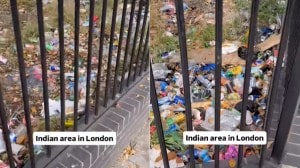Stay updated with the latest - Click here to follow us on Instagram
Past Continuous
Each of Satish Gujrals exhibitions is like a different compartment of the same train. Every series has a sliver of the past,like a strain of thought copied and pasted into the present.
Each of Satish Gujrals exhibitions is like a different compartment of the same train. Every series has a sliver of the past,like a strain of thought copied and pasted into the present. So in his exhibition Times Whirlwind in Kolkata in 2009,he explored the relationship between man and technology. In his ongoing exhibition A Tryst With Modernity And Tradition in Mumbai,he soups up the recipe by throwing in gods and goddesses into the equation.
The gods are flamboyantly dangling from the levers of machines operated by humans,cheekily teetering on the brinks and nimbly dancing on truncated parts of the machines. Like all his paintings,the Gujral mainstays are easily visiblevicious colours,fragmented imagery and painstaking attention to detail.
It amazes me how Indians have adapted to modernity and modern facilities,like electricity and mobile phones,without letting go of their religious traditions, says Gujral,although he himself waves aside claims of being religious. I wouldnt say Im a traditionalist or a modernist. I believe in what I see.
His involvement with questions of modernity goes a long way back to the 40s when Gujral came in contact with the Progressive Artists Group,which included compatriots M F Husain,F N Souza and S H Raza and rejected their idea of modernity which had no place for tradition.
Since then,the Delhi-based artist has come a long waydabbling in architecture,graphic art and sculpture in addition to painting,not only picking up awards (including three National Awards and a Padma Vibhushan) with an alarming frequency. He has also added new dimensions to Indian art like sculptures in burnt wood and paper collages. When I find everything has been done in a particular medium,I drop it and shift to another, says the 84-year-old,whos showcasing 32 paintings,15 sculptures and 10 drawings in his current exhibition.
From his Partition series,which consists of some of Gujrals most acclaimed paintings in the 50s,its like hes come full circle with his mind drained of the disturbed angst of those days and replaced by an organised precision. When I painted Partition,no one else saw it the way I did because no one else was involved with it the way I was, says Gujral,who helped his father assist refugees. As a result,his family was imprisoned several times. My brother was imprisoned first when he was 10 years old. As my sisters were too young to take care of themselves,my mother would take them along with her to prison.
A Tryst With Modernity And Tradition at Jehangir Art Gallery till February 23







